
The S-train is a type of hybrid urban-suburban rail serving a metropolitan region. Some of the larger S-train systems provide service similar to rapid transit systems, while smaller ones often resemble commuter or even regional rail. They are especially common in Germany and Austria, where they are known as S-Bahn, which in the 1930s was an abbreviation of either Schnellbahn, Stadtbahn or Stadtschnellbahn, depending on the city, but they must not be confused with U-Stadtbahnen. Similar S-train systems exist also in Switzerland known as S-Bahn as well. In Denmark, they are known as S-tog[ˈesˌtsʰɔˀw], in the Czech Republic as Esko or S-lines, and northern Italy as Servizio ferroviario followed by either the word "metropolitano" or "suburbano".
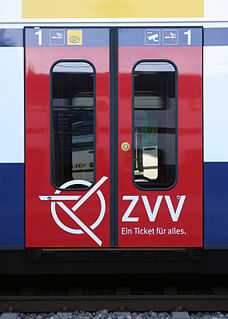
The Zürich S-Bahn system is a network of rail lines that has been incrementally expanded to cover the ZVV area, which comprises the entire canton of Zürich and portions of neighbouring cantons, with a few lines extending into or crossing the territory of southern Germany. The network is one of many commuter rail operations in German speaking countries to be described as an S-Bahn.

The Hamburg S-Bahn is a suburban commuter railway network in the Hamburg Metropolitan Region. Together, the S-Bahn, the Hamburg U-Bahn, the AKN railway and the regional railway form the backbone of railway public transport in the city and the surrounding area. The network has operated since 1907 as a commuter rail system, under the direction of the state railway, and is a member of the Hamburger Verkehrsverbund. There are six lines, serving 68 stations, on 147 kilometres (91 mi) of route. On an average working day the S-Bahn transports about 590,000 passengers; in 2010 about 221 million people used the S-Bahn.

The Hamburg U-Bahn is a rapid transit system serving the cities of Hamburg, Norderstedt and Ahrensburg in Germany. Although technically an underground, most of the system's track length is above ground. The network is interconnected with the city's S-Bahn system, which also has underground sections. It is operated by Hamburger Hochbahn within the Hamburger Verkehrsverbund (HVV). It was opened in February 1912, and comprises four lines serving 93 stations, with a route length of 106.4 kilometres (66.1 mi) in 2019.

Hamburg Hauptbahnhof is the main railway station of the city of Hamburg, Germany. Opened in 1906 to replace 4 separate terminal stations, today Hamburg Hauptbahnhof is operated by DB Station&Service AG. With an average of 550,000 passengers a day, it is Germany's busiest railway station and the second-busiest in Europe after the Gare du Nord in Paris. It is classed by Deutsche Bahn as a category 1 railway station.

Hamburg-Altona is a railway station in Hamburg, Germany, situated to the west of the city's main station, in the district which bears its name.

Landungsbrücken is a railway station and transport hub, located in Hamburg's St. Pauli quarter at the Landungsbrücken. It is part of the City S-Bahn line and the Hamburg U-Bahn.

Jungfernstieg is an underground railway station in the city centre of Hamburg, Germany, served by the underground railway (U-Bahn) and the suburban railway (S-Bahn). The station is one of Hamburg's busiest rapid transit hubs.
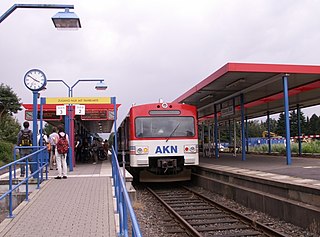
AKN Eisenbahn GmbH operates commuter and freight trains in Hamburg and Schleswig-Holstein. Its headquarters is in Kaltenkirchen. It is a member of the Hamburger Verkehrsverbund (HVV), which organises public transport in and around Hamburg.
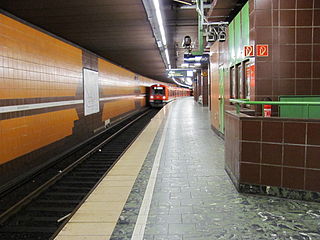
Königstraße is a railway station served by the rapid transit trains of Hamburg S-Bahn lines S1, S2 and S3. The station is located on the underground City S-Bahn line in Altona's Old Town quarter in the Hamburg borough of Altona, Germany. Like all Hamburg S-Bahn stations, Königstraße station is managed by the DB Station&Service GmbH.

Stadthausbrücke is an underground railway station, on the City S-Bahn line of the Hamburg S-Bahn. The station is located in New Town quarter of the Hamburg borough of Mitte (centre), Germany. The station is managed by DB Station&Service.
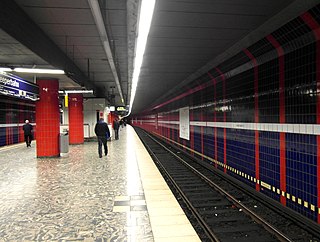
Reeperbahn is a Hamburg S-Bahn station in St. Pauli, Hamburg, Germany, located at the eastern end of the Reeperbahn. Reeperbahn station is part of the City S-Bahn tunnel from Hamburg main station in St. Georg to Hamburg-Altona station in Altona, and opened on 21 April 1979.
The name Verbindungsbahn is used in Stuttgart to describe the underground connecting line between the subterranean S-Bahn Stuttgart station at Stuttgart Hauptbahnhof and the tunnel exit at the station in Stuttgart-Österfeld, which connects, via tunnel, the Stuttgart valley and the Filder plateau. The term originates from the planning stages in the 1960s, when similar projects for the S-Bahn München and S-Bahn Rhein-Main were given the same term.

The Berlin North-South main line, also called the North-South link (Nord-Süd-Verbindung) is an electrified railway line in Berlin which was opened in 2006. It is an important component of the “mushroom concept” (Pilzkonzept) adopted for long-distance and regional rail services through the city. Its core is an approximately 3.5 km long tunnel under the Tiergarten in Berlin. The tunnel section includes the underground level of Berlin Hauptbahnhof and the Potsdamer Platz regional station. The above-ground section of the line includes the Berlin Südkreuz station.
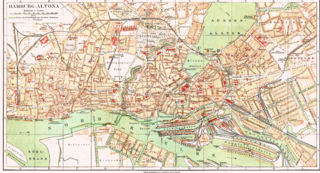
The Hamburg-Altona link line is a railway line in Hamburg, Germany. It now connects the lines from the north and west of Hamburg and Altona station with Hamburg Hauptbahnhof and the lines to the south and east. It was initially designed as a freight line only but is it now one of the busiest lines in Germany. It includes the suburban tracks of the Hamburg Stadtbahn, originally the core of the Hamburg S-Bahn.

The Alster Valley Railway is a railway line in Hamburg, which is nearly six-kilometre long. It is entirely double track and is served by line S1 of the Hamburg S-Bahn along its entire length. It leaves the extension of the Hamburg-Altona link line at Ohlsdorf station and runs to Poppenbüttel. The original plans envisaged an extension to Wohldorf or Volksdorf.
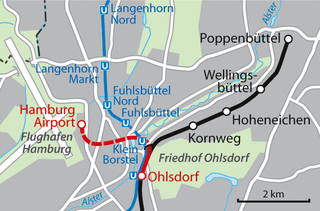
The Hamburg Airport S-Bahn line is a nearly three-kilometre long section of the Hamburg S-Bahn. It was opened on 11 December 2008.

The Essen Stadtbahn is a 19.6-kilometer (12.2 mi) light rail (Stadtbahn) network in Essen and the two neighbouring towns of Mülheim an der Ruhr and Gelsenkirchen in the German state of North Rhine Westphalia. It forms part of the Rhine-Ruhr Stadtbahn.

The Hamburg freight rail bypass is a railway line in the German city of Hamburg. It runs from Hamburg-Eidelstedt via Hamburg-Rothenburgsort to Hamburg-Harburg and connects the long-distance railways approaching Hamburg, bypassing the link line and the railway junctions on the approaches to Hamburg-Altona station and Hamburg Hauptbahnhof. The line is mainly used for rail freight.

The U1 is a line of the Hamburg U-Bahn which has a length of 55.383 kilometres (34.41 mi). It serves 47 stations. The line opened in 1914. It starts in Norderstedt Mitte and leads via the city center at Hauptbahnhof Süd to Volksdorf where it divides in two branches, leading to Ohlstedt and Großhansdorf.




















